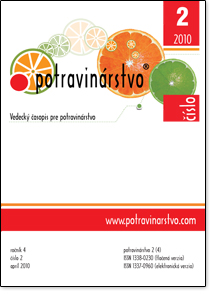Migration of phthalates from plastic tank to vegetable oil as a part of feeding mixtures used for chicken broilers fattening
DOI:
https://doi.org/10.5219/49Keywords:
DBP, DEHP, analysis, monitoring, contamination, feed material, plasticAbstract
The concentrations of phthalic acid esters (PAEs) as di-n-butyl phthalate (DBP) and di-2-ethylhexyl phthalate (DEHP) were measured in samples of rapeseed oil, which was used as a feed. First samples were collected during the production process and second after the storage in plastic tank (21 days). The results of measurements are that there is 2.93-10.10 mg PAEs.kg-1 in the oil before storage and 22.73-61.55 mg PAEs.kg-1 after storage.
For the monitoring of distribution and accumulation of PAEs in animal tissues and organs (muscles, adipose tissue, skin and liver) broiler chicks ROSS 308 were used. The chicks were divided into 4 groups (50 chicks each). All the chicks were fed by commercial diets (complete feed, KKS) for broiler chicks (starter – BR1; grower – BR2 and finisher – BR3). The experimental diets were supplemented with vegetable oil (RO) with low (group N) or high (group V) phthalate content, or animal fat with high phthalate content (group Z). Neither the control diets (K) nor the grower (BR1) diets contained vegetable oil or animal fat. DBP and DEHP were found in all tissues of all chicks. The highest concentration of DBP of 1.28 1.00 mg.kg-1 of fresh sample (an average value from 8 chicks) was determined in the adipose tissue of V chicks. The highest concentration of DEHP of 3.27 2.87 mg.kg-1 of fresh sample (average of 8 chicks) was also determined in the V group.
Downloads
Metrics
References
HARAZIM, J., JAROŠOVÁ, A., KRÁTKÁ, L., STANCOVA, V., SUCHÝ, P., 2008. Contamination of feedstuffs with phthalic acid esters. In Toxicology Letters, 2008, 180: 67. ISSN 0378-4274. DOI: https://doi.org/10.1016/j.toxlet.2008.06.564
HÖGBERG, J., HANBERG, A., BERGLUND, M., SKERFVING, S., REMBERGER, M., CALAFAT, A. M., FILIPSSON, A. F., JANSSON, B., JOHANSSON, N., APPELGREN, M., HAKANSSON, H. 2008. Phthalate Diesters and Their Metabolites in Human Breast Milk, Blood or Serum, and Urine as Biomarkers of Exposure in Vulnerable Populations. In Environmental Health Perspectives. vol. 116, no. 3, 2008, p. 334–339. ISSN 0091-6765. DOI: https://doi.org/10.1289/ehp.10788
IMHOF, R., GAUCH, R., SIEBER, R., BOSSET, J. 1994. About some volatile organic pollutants in milk and dairy products. In Mitteilungen aus dem Gebiete der Lebensmittelunterschung und Hygiene. vol. 85, no. 6, 1994, p. 681–703.
JAROŠOVÁ, A., GAJDŮŠKOVÁ, V., RASZYK, J., ŠEVELA, K. 1998. Determination of phthalic acid esters (PAEs) in biological materials by HPLC. In Czech Journal of Food Sciences. vol. 16, 1998, p. 122–130. ISSN 1212-1800.
JAROŠOVÁ, A., GAJDŮŠKOVÁ, V., RASZYK, J., ŠEVELA, K. 1999. Di-2-ethylhexyl phthalate and di-n-butyl phthalate in the tissues of pigs and broiler chicks after their oral administration. In Veterinarni Medicina, vol. 44, no. 3, 1999, p. 61–70. ISSN 0375-8427.
JAROŠOVÁ, A., HARAZIM, J., KRÁTKÁ, L., KOLENČÍKOVÁ, D. 2009a. Screening of phthalic acid esters in feed ingredients, premixes and feed additives in the Czech republic.Environmental Chemistry Letters, Published online: 11 september 2009 (DOI 10.1007/s 10311-009-0237-7). ISSN 1804-0152.
JAROŠOVÁ, A., HARAZIM, J., SUCHÝ, P., KRÁTKÁ, L., STANCOVÁ, V. 2009b. The distribution and accumulation of phthalates in the organs and tissues of chicks after the administration of feedstuffs with different phthalate concentrations. In Veterinarni Medicina. vol. 54, no. 9, 2009, p. 427–434. ISSN 0375-8427. DOI: https://doi.org/10.17221/2/2009-VETMED
KOCH, H. M., PREUSS, R., ANGERER, J. L. 2006. Di(2-ethylhexyl)phthalate (DEHP): human metabolism and internal exposure-- an update and latest results. InInternational Journal of Andrology. vol. 29, no. 1, 2006, p. 155–165. ISSN 0105-6263. DOI: https://doi.org/10.1111/j.1365-2605.2005.00607.x
LATINI, G. 2005. Monitoring phthalate exposure in human. In Clinica Chimica Acta, vol. 36, 2005, p. 20–29. ISSN 1803-7364. DOI: https://doi.org/10.1016/j.cccn.2005.05.003
MARTINO-ANDRADE, A. J., CHAHOUD, I. 2010 Reprodctive toxicity of phthalate esters. In Molecular Nutrition & Food Research, vol. 54, no. 1, 2010, p. 148–57. ISSN 1613-4125. DOI: https://doi.org/10.1002/mnfr.200800312
RASZYK, J., GAJDŮŠKOVÁ, V., JAROŠOVÁ, A., SALAVA, J., PALÁC, J. 1998. Occurrence of phthalic acid esters (PAEs) in combined feedstuffs and adipose tissues of swine and cattle. In Veterinarni Medicina, vol. 43, 1998, p. 93–95. ISSN 0375-8427.
SCHETTLER, T. 2006. Human exposure to phthalates via consumer products. In International Journal of Andrology, vol. 29, 2006, p. 134–139. ISSN 1365-2605. DOI: https://doi.org/10.1111/j.1365-2605.2005.00567.x
TICKNER, J. A., SCHETTLER, T., GUIDOTTI, T., MCCALLY, M., ROSSI, M., 2001. Health risks posed by use of Di-2-ethylhexyl phthalate (DEHP) in PVC medical devices: a critical review. In American Journal of Industrial Medicine, vol. 39, no. 1, 2001, p. 100–111. ISSN 0271-3586. DOI: https://doi.org/10.1002/1097-0274(200101)39:1<100::AID-AJIM10>3.0.CO;2-Q
WORMUTH, M., SCHERINGER, M., VOLLENWEIDER, M., HUNGERBUHLER, K. 2006. What are the sources of exposure to eight frequently used phthalic acid esters in Europeans? In Risk Analysis. vol. 26, 2006, p. 803–824. ISSN 1573-9147. DOI: https://doi.org/10.1111/j.1539-6924.2006.00770.x
ZAR, J. H. 1999. Biostatistical analysis. Prentice Hall, Uppwer Saddle River, N.J. ZHU, J., PHILIPS, S. P., FENG, Y. L., YANG, X. 2006. Phthalate esters in human milk: Concentration variations over a 6-month postpartum time. In Environmental science & technology, vol. 40, no. 17, 2006, p. 5276–5281. ISSN: 0013-936X. DOI: https://doi.org/10.1021/es060356w
Downloads
Published
How to Cite
Issue
Section
License
This license permits non-commercial re-use, distribution, and reproduction in any medium, provided the original work is properly cited, and is not altered, transformed, or built upon in any way.






























